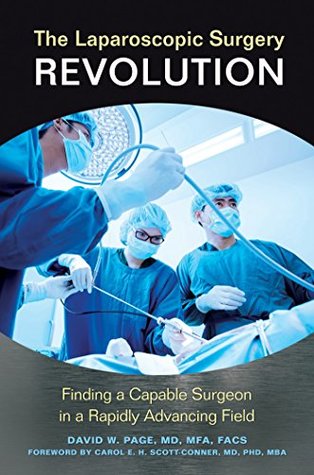Read The Laparoscopic Surgery Revolution: Finding a Capable Surgeon in a Rapidly Advancing Field - David W. Page file in ePub
Related searches:
What followed can only be described as a revolution in general surgery, as well as urology and gynecology. Lapa-roscopic cholecystectomy was introduced to the general surgery world in the exhibit hall of the american college of surgeons annual meeting in october 1989.
Laparoscopic cholecystectomy, reported on by general surgeons in the late 1980s, was a major catalyst that propelled the worldwide use of laparoscopy. 4 the acceptance of laparoscopic cholecystectomy was an important milestone as general surgeons soon began treating other abdominal conditions with laparoscopic methods that were previously.
Laparoscopic surgery is a transition technology that marked the beginning of the information age revolution for surgery.
We continue to monitor covid-19 cases in our area and providers will notify you if there are scheduling changes. We are providing in-person care and telemedicine appointments.
Llr will not totally supplant open liver surgery, and major llr remains to be technically challenging procedure.
30 nov 2019 many have described the advent of laparoscopy as a change to surgery as “ revolutionary to this century as the development of anaesthesia.
A hernia occurs when there is weakness or even a whole in a muscle that allows tissue or organs to bulge up through the defect. Hernias range widely in severity from hardly noticeable to life-threatening.
The revolution of laparoscopic techniques in bariatric surgery is described in this summary. Advances in minimal invasive techniques have contributed to reduced operative time, length of stay, and complications.
Laparoscopic surgery -- a revolution in the field of gynecology. Pip: minimally invasive surgery is performed through a key hole incision using a laparoscope. Even though laparoscopy can be used to perform gynecologic surgery, most practicing gynecologists in india do not yet know how to perform laparoscopic surgery.
The advent of laparoscopic surgery has created a revolution in abdominal surgeries. Initially applied just for diagnostic purpose, it has rapidly gained popularity for the management of appendicitis and gallstone disease, making it the gold standard treatment for these conditions.
In addition, the revolution of laparoscopic surgery brought to bear ethical considerations and the harsh reality of medical legal and economic ramifications of new technology introduction. Finally, minimally invasive surgery challenged dogma of traditional perioperative care, allowing streamlining of postoperative recovery.
General surgeons rely on mdedge/surgery to cover the world of medicine to bring them breaking news, on-site medical meeting coverage, and expert perspectives.
The revolution incited by laparoscopic cholecystectomy, however, has exhausted its initial unbridled enthusiasm. Interest in laparoscopy remains high, but thoughtful surgeons in academic and clinical communities are examining laparoscopic procedures in the light of clinical out-comes and risk/benefit/cost ratios.
Academic surgeons, such as cuschieri, berci, and mcsherri, called for a moratorium on the new surgery, arguing that the procedure should be evaluated and validated first in specialized centers. 15 quite to the contrary, in many areas, laparoscopic cholecystectomy began in private practice and later migrated to academic centers.
The advent of laparoscopic surgery has created a revolution in abdominal surgeries. Initially applied just for diagnostic purpose, it has rapidly gained popularity.
The october 1989 american college of surgeons (acs) clinical congress should be recognized as an important moment in the history of modern surgery. It was at this meeting that much of the enthusiasm for laparoscopic cholecystectomy was generated, triggering what is sometimes referred to as the “laparoscopic revolution” in general surgery.
This operation may be beneficial in certain populations of women, provided the surgeon has the necessary expertise and counsels the patient thoroughly before proceeding teresa tam, mddr.
Laparoscopic surgery consists in performing complex procedures through small cuts, to look bright with the use of revolutionary tools such as the laparoscope.
In 1910 hans christian jacobaeus of sweden reported the first laparoscopic operation in humans.
At johns hopkins, we host the only minimally invasive and robotic pediatric urology program in maryland. If there are changes in surgeries or other scheduled appointments, your provider will noti.
Laparoscopic surgery: an evolving revolution november 2000 jsls: journal of the society of laparoendoscopic surgeons / society of laparoendoscopic surgeons 5(1):95-6.
Amazon配送商品ならthe laparoscopic surgery revolution: finding a capable surgeon in a rapidly advancing fieldが通常配送無料。更にamazonなら.
• explains how the success of the laparoscopic revolution that began in the late 1980s has resulted in a new definition of surgeon capability―and how the more complicated education, training, and technology that laparoscopy entails has set the stage for a perfect surgical storm.
Laparoscopic surgery has proven to be a significant medical advance, turning major surgeries that left scars and kept patients in the hospital for several days, into.
The first world witnessed a laparoscopic revolution in the 1990s. At the start, laparoscopic surgery was heavily criticized and ridiculed.
The laparoscopic surgery revolution minimally invasive or no incision surgery sounds attractive, but laparoscopic operations involve their own risks and disadvantages.

Post Your Comments: